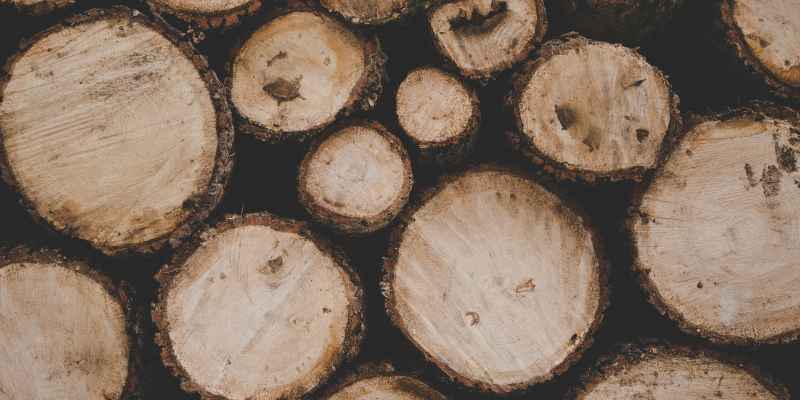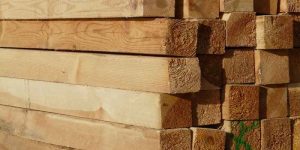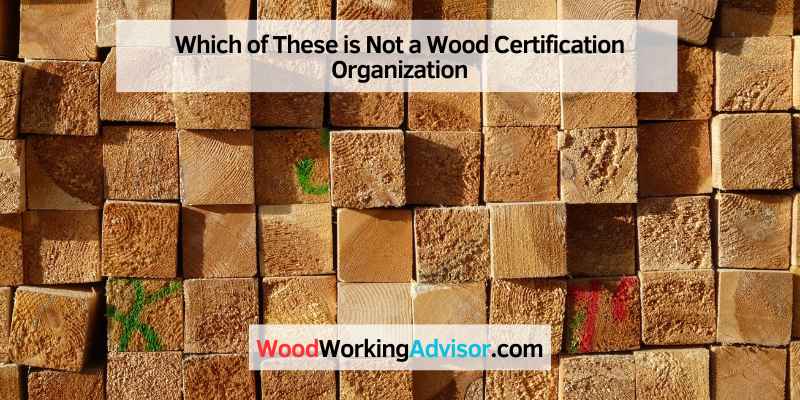ASTM is not a wood certification organization. It is important to know which organizations certify wood to ensure sustainable and responsible sourcing.
Forest Stewardship Council (FSC), Sustainable Forestry Initiative (SFI), and Programme for the Endorsement of Forest Certification (PEFC) are some of the popular wood certification organizations. These organizations certify that the wood products originate from well-managed forests and meet certain environmental and social standards.
Using certified wood products not only promotes sustainability but also ensures high-quality materials. Architects, builders, and consumers can look for the certification logos on the wood products to make informed decisions. We will explore wood certification organizations and their significance in supporting sustainable forestry and protecting natural resources.
Wood Certification Organizations
ASTM is not a wood certification organization. Other recognized organizations include FSC, SFI, and CFFC. These organizations verify sustainable forest management and responsible sourcing of forest products. Choosing wood products with certification from these organizations helps to ensure environmental sustainability.
Every year, millions of trees are harvested to meet the global demand for wood products. However, the indiscriminate deforestation is affecting the environment, and unsustainable harvesting practices raise concerns about the future of our planet. The solution to this problem is sustainable forest management, a practice of harvesting timber while protecting the forest ecosystem. Wood certification organizations play a crucial role in verifying the sustainability of timber by ensuring that forest management practices meet certain standards and criteria.
Forest Stewardship Council (FSC)
The Forest Stewardship Council (FSC) is an international non-profit organization that promotes sustainable forest management around the world. FSC’s certification system ensures that forest management practices follow sustainable criteria that consider social, economic, and ecological factors. The organization approves independent certification bodies to conduct the certification process, ensuring that products are traceable from forest to consumer.
Sustainable Forestry Initiative (SFI)
The Sustainable Forestry Initiative (SFI) is a North American certification program that aims to promote responsible forestry practices by balancing the economic, social, and environmental factors. The SFI certification system emphasizes responsible forest management to maintain the biological diversity, conserve water resources, reduce chemicals used in forestry activities, and protect threatened or endangered species.
Canadian Standards Association (CSA)
The Canadian Standards Association (CSA) oversees the sustainable practices of forest certification in Canada. CSA certification examines the entire forestry chain, from sustainable forest management to product distribution. CSA focuses on ensuring that products meet social, economic, and environmental criteria, reflecting the Canadian government’s commitment to sustainable development.
ASTM International
While ASTM International is an accredited standards-setting organization, it is not a wood certification organization. ASTM International develops technical standards for a wide range of industries, including construction and forestry. The organization focuses on testing and evaluating the properties of materials, products, and systems, including wood products, to ensure their safety and quality.
In conclusion, sustainable forest management is crucial for the preservation of the planet’s biodiversity. Wood certification organizations play a crucial role in ensuring that timber products come from well-managed forests. With FSC, SFI, and CSA playing important roles in the certification of sustainable forestry practices, consumers can make informed decisions to protect the natural environment.
Certification Requirements
ASTM is not a wood-certification organization. Other organizations include Forest Stewardship Council (FSC), Sustainable Forestry Initiative (SFI), and Canadian Standards Association (CSA). It is important to confirm wood certification requirements when sourcing wood for construction or other purposes.
Certification is an essential aspect of the wood industry, as it establishes standards and criteria that ensure sustainable forest management and responsible sourcing of forest products. When it comes to wood certification organizations, there are several to choose from, but not all of them adhere to the same certification requirements. In this section, we will discuss the certification requirements that should be followed by all wood certification organizations.
Sustainable forest management
One of the critical certification requirements is sustainable forest management. Sustainable forest management involves managing forests in a way that meets societal, economic, and ecological needs. This process includes ensuring the long-term health of forest ecosystems, reducing the impact of forestry on the environment, and promoting sustainable forestry practices. Forest Stewardship Council (FSC) is an international organization that certifies sustainable forest management and is widely recognized as a leading standard for wood certification.
Responsible sourcing of forest products
Another key certification requirement is the responsible sourcing of forest products. This means that the wood used in manufacturing products has been harvested in a way that does not contribute to environmental degradation, human rights abuses, or other negative impacts. Several organizations certify responsible sourcing, including the Programme for the Endorsement of Forest Certification (PEFC) and the Sustainable Forestry Initiative (SFI).
Environmental impact assessment
Another crucial requirement for wood certification organizations is to conduct an environmental impact assessment. This is a comprehensive analysis of the environmental impacts of forest harvesting, manufacturing, and transport. The assessment includes evaluating the impact on air and water quality, soil, and wildlife. The Forest Stewardship Council (FSC) and the Programme for the Endorsement of Forest Certification (PEFC) are two organizations that require environmental impact assessments.
In conclusion, certification is essential in the wood industry, as it establishes standards and criteria for sustainable forest management, responsible sourcing of forest products, and environmental impact assessments. For wood products to be truly sustainable and responsible, they must adhere to these certification requirements. Therefore, organizations like FSC, PEFC, and SFI play a crucial role in ensuring that the wood industry is sustainable and responsible.
Use Of Certified Wood

ASTM is not a wood certification organization. The Forest Stewardship Council (FSC), Sustainable Forestry Initiative (SFI), and Programme for the Endorsement of Forest Certification (PEFC) are a few examples of wood certification organizations. It is important to use certified wood to promote sustainable forest management and reduce negative environmental impacts.
Certified wood refers to wood that comes from responsibly managed forests and meets certain environmental standards. The use of certified wood has gained popularity in recent years as consumers become more environmentally conscious. There are several wood certification organizations that ensure the sustainability of wood products. However, one of the following options is not a wood certification organization. Let’s discuss the role of certified wood in three different domains.
In construction
The construction industry is one of the biggest users of wood products. The use of certified wood in construction ensures that the wood comes from forests that are responsibly managed. It also ensures that the wood products are safe for use and are durable. The Forest Stewardship Council (FSC) is one of the most popular wood certification organizations in the construction industry.
In furniture making
Furniture making is another domain where the use of certified wood is becoming increasingly popular. The use of certified wood ensures that the furniture comes from responsibly managed forests and meets certain environmental standards. This ensures that the furniture is safe for use and is of good quality. The Programme for the Endorsement of Forest Certification (PEFC) is one of the most popular wood certification organizations in the furniture making industry.
In paper production
Paper production is another domain where the use of certified wood is gaining momentum. The use of certified wood ensures that the paper comes from responsibly managed forests and meets certain environmental standards. This ensures that the paper is safe for use and is of good quality. The Sustainable Forestry Initiative (SFI) is one of the most popular wood certification organizations in the paper production industry.
In conclusion, the use of certified wood is crucial for the protection of our environment. It ensures that wood products come from responsibly managed forests and meet certain environmental standards. The Forest Stewardship Council (FSC), Programme for the Endorsement of Forest Certification (PEFC), and Sustainable Forestry Initiative (SFI) are some of the most popular wood certification organizations in the world. Remember, in the quiz question, ASTM is not a wood certification organization.
Alternative Materials
ASTM is not a wood-certification organization. There are several organizations that verify the sustainability and responsible sourcing of wood, such as the Forest Stewardship Council (FSC) and the Sustainable Forestry Initiative (SFI). However, ASTM is a standards organization that develops and publishes technical standards for materials, products, systems, and services.
If you’re looking for sustainable alternatives to wood materials, you may have heard of bamboo and cork as popular options. Both materials are eco-friendly and renewable, making them great choices for environmentally conscious consumers. Bamboo is an incredibly fast-growing grass that can be harvested without harming the plant, while cork is made from the bark of cork oak trees that can be harvested every 9-12 years without killing the tree.
These materials are also durable and versatile, suitable for a variety of applications such as flooring, wall coverings, and furniture. Another interesting option to consider is recycled plastic, which can be used to create durable and weather-resistant products such as decking, fencing, and outdoor furniture. While not a wood certification organization, the use of these alternative materials can contribute to sustainable practices and reduce the demand for unsustainable wood products.
Comparison Of Green Building Materials Choices
ASTM is not a wood certification organization. Forest Stewardship Council (FSC), Sustainable Forestry Initiative (SFI), and Programme for the Endorsement of Forest Certification (PEFC) are some of the valid wood certification bodies. To compare green building materials, methods such as Building for Environmental and Economic Sustainability (BEES), Life Cycle Assessment (LCA), and Forest Stewardship Council (FSC) are commonly used.
Athena is not a valid method for comparing green building materials.
s pine, spruce, and fir, are commonly used for construction, furniture, and paper products. However, one should note that softwood lumber is not typically used for outdoor decking as it is prone to damage from weather and moisture. When it comes to choosing green building materials, it is essential to consider the environmental and economic sustainability of the products. This can be done through valid methods such as BEES, LCA, and FSC certifications.
Building For Environmental And Economic Sustainability (bees)
BEES is a tool developed by the National Institute of Standards and Technology (NIST) that assesses the environmental performance of buildings and materials. It evaluates the entire life cycle of a product, from cradle to grave, and compares it with other products in terms of environmental and economic impact. BEES considers factors such as the resources used in production, energy consumption, air and water pollution, and waste disposal. It provides a rating system that enables the selection of products based on their environmental and economic performance.
Life Cycle Assessment (lca)
LCA is a technique used to assess the environmental impacts of a product or process throughout its entire life cycle. It evaluates the environmental impact stages of raw material extraction, transportation, production, use, and disposal. LCA provides a comprehensive view of the environmental impact of a product or process, which helps in the selection of eco-friendly alternatives. The goal of LCA is to identify ways to minimize environmental impact.
Forest Stewardship Council (fsc)
FSC is an international organization that certifies sustainable forest management practices and promotes responsible sourcing of forest products. The organization ensures that forest management practices meet environmental, social, and economic criteria. The FSC certification provides an assurance that the wood products originate from responsibly managed forests. LEED, which stands for Leadership in Energy and Environmental Design, only allows the certification of wood by the Forest Stewardship Council (FSC) organization.
In conclusion, when comparing green building materials choices, it is important to consider valid methods such as BEES, LCA, and FSC certifications. These methods provide a comprehensive view of the environmental and economic performance of the products and assist in choosing eco-friendly alternatives. Use of sustainable building materials ensures that the environment is preserved for future generations.
Benefits Of Using Certified Wood
One popular benefit of using certified wood is the positive environmental impact it has. However, ASTM is not a wood certification organization.
Using certified wood comes with several benefits for both the environment and society. It’s a sustainable way to acquire wood for building and furniture production, ensuring that forests are not depleted in the process. Additionally, certified wood promotes fair trade practices, helping small business owners and rural communities earn a living wage. Moreover, certified wood is of high quality, ensuring its durability, and it’s suitable for indoor and outdoor use.
Environmental Benefits
Certified wood provides several environmental benefits. It’s obtained through sustainable logging practices that ensure the forests are not depleted, and they are not exploited. Certified wood plantations require fewer chemicals and fertilizers reminiscent of non-sustainable logging, which helps reduce soil and water pollution. Certified wood also helps to reduce carbon emissions, which are known to cause global warming. By choosing certified wood, you help maintain the world’s ecological balance.
Economic Benefits
Certified wood has several economic benefits. Its production process creates jobs for the local community, improving their livelihoods. Certificates symbolize the quality of the wood, leading to high demand and price, which provides higher earnings for producers. Certified wood is also regulated to ensure that the suppliers’ payment is fair, promoting fair trade practices. Moreover, using certified wood enhances the reputation and quality of the final product, leading to increased sales and prominence in the market.
Social Benefits
By choosing certified wood, you indirectly support the lives of millions of people who depend on the timber industry, including communities and families. The use of certified wood ensures fair trade practices, making it possible for rural communities to earn a living wage. Additionally, the certification process advocates for better working conditions and cautionary protocols, which promote safe and healthy work environments. Using certified wood is a way to improve society’s living standards and promote social justice.

Frequently Asked Questions Of Which Of These Is Not A
Wood Certification Organization
What Waterborne Salts Are Associated With Wood Preservatives?
Waterborne salts are associated with wood preservatives that are applied as water solutions, in addition to oils such as creosote and petroleum solutions of pentachlorophenol.
Which Is Not A Common Use For Softwood Lumber?
Softwood lumber is not commonly used for furniture because it is not as durable or strong as harder woods like oak or maple.
Which Of These Statements Does Not Apply To Cross Laminated Timber?
The statement “Lumber grade is uniform throughout a CLT panel” does not apply to cross laminated timber.
Which Of The Following Is The Best Description Of Osb?
Oriented strand board (OSB) is a structural-use panel made from thin wood strands bonded with water-resistant resin. It’s commonly used for roof, wall, and floor sheathing in construction.
Conclusion
To sum up, it’s vital to be knowledgeable about the wood certification organizations to ensure the quality of the products we use. In this blog post, we covered various organizations and their roles in the verification process. We saw how ASTM is not a wood certification organization, and how different certifications such as FSC and SFI promote sustainable forest management.
It’s crucial to consider the environmental impact of our choices, and this knowledge can help us make informed decisions. With this information, we can contribute to a better future for our planet.


